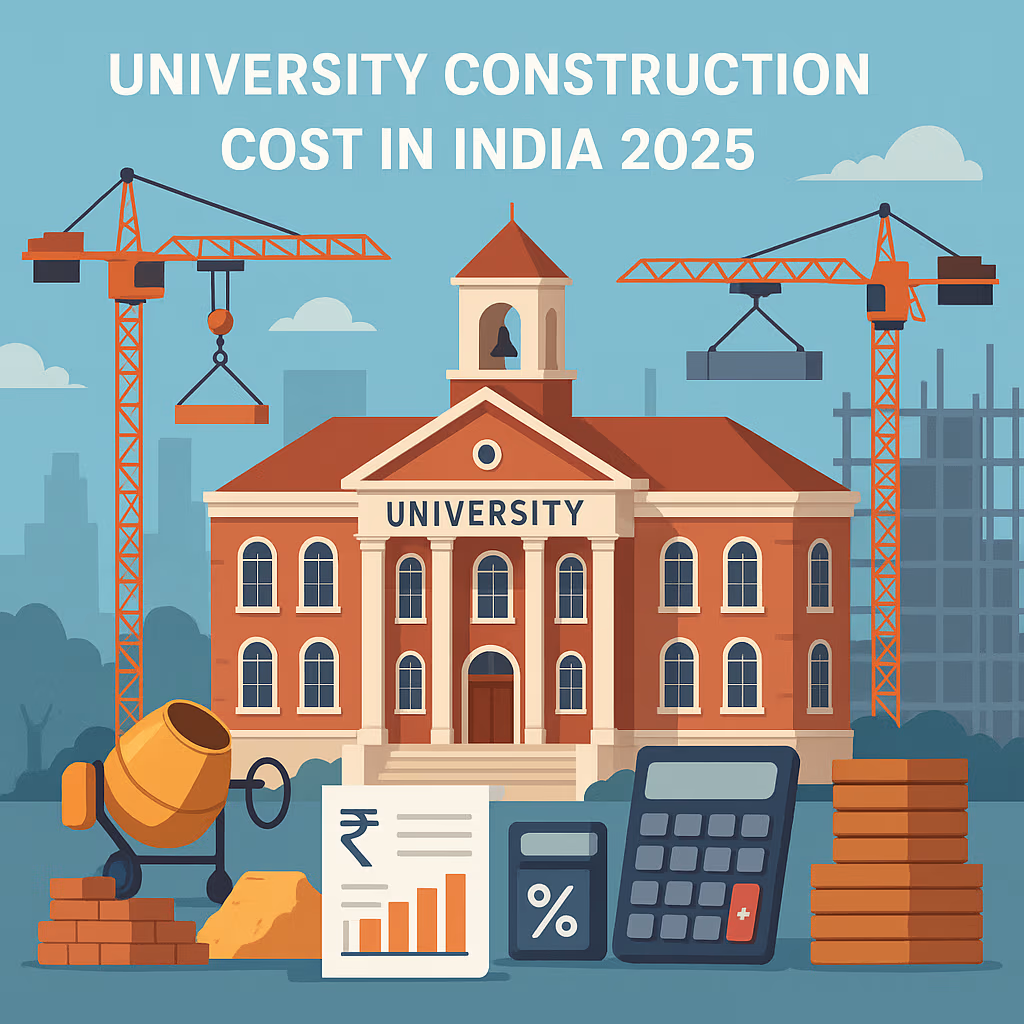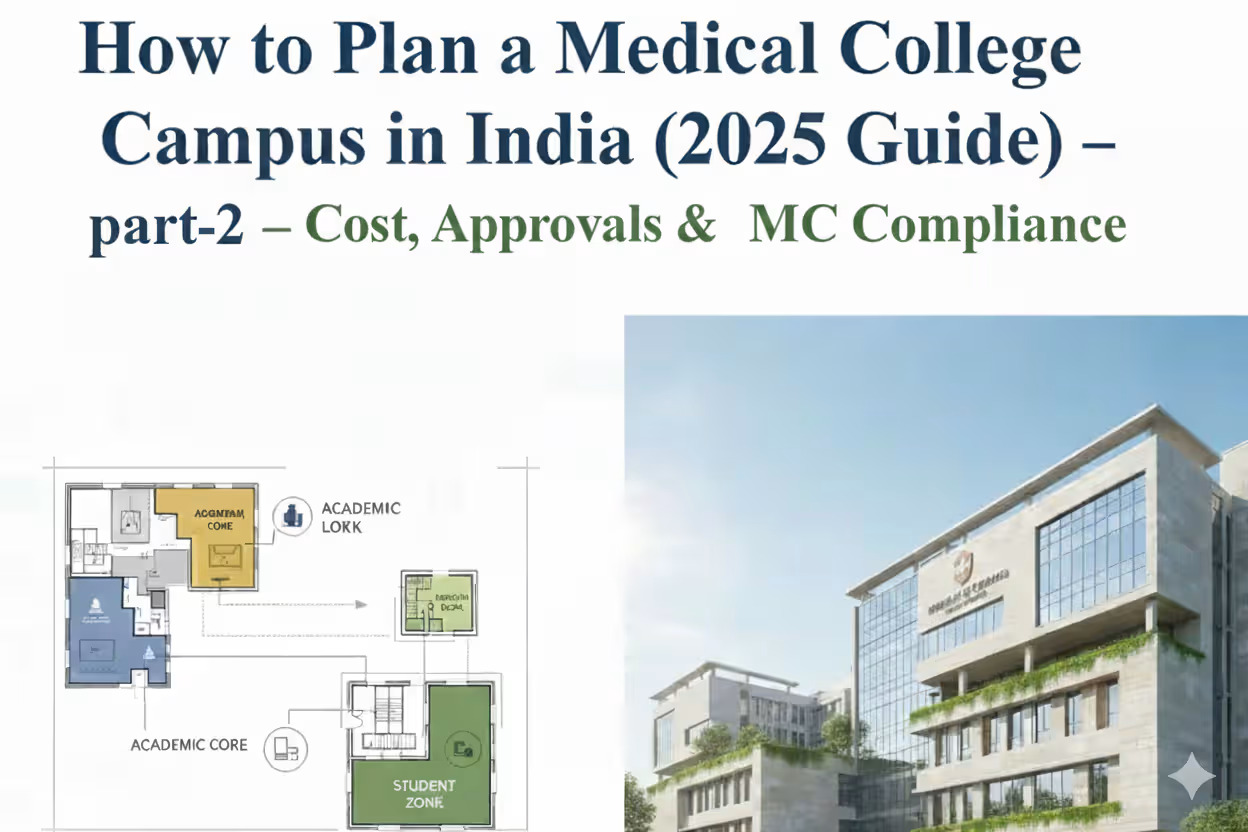University Construction Cost in India 2025

Table of content
In 2025, India’s higher education landscape is undergoing a construction boom, with private universities, public institutions, and trust-backed campuses competing to expand capacity in line with the National Education Policy (NEP) 2020 targets for gross enrolment ratio (UGC). Yet, building a compliant, cost-efficient university in India is a complex equation — balancing per-sq-ft construction costs, national building codes, UGC space norms, and volatile material prices.
According to the Central Public Works Department (CPWD) Plinth Area Rates (PAR) 2023, updated with a Delhi cost index of 107 as of April 2023, the shell-and-core cost for educational buildings ranges between ₹2,000 and ₹3,400 per sq ft, depending on building type (CPWD PAR 2023). In mid-2025, the Wholesale Price Index (WPI) showed moderate annual inflation, with cement and basic metals remaining relatively stable, though small fluctuations can still nudge budgets (Press Information Bureau, Office of the Economic Adviser).
For promoters, EPC contractors, and project management teams, the real challenge lies in moving beyond headline rates to understand the complete cost stack — from MEP systems (+25–35%) to interiors (+10–18%), external development (+7–12%), and statutory compliance (+4–9%). Misjudging these can derail project timelines, strain funding, or force last-minute scope cuts.
This guide to university construction cost in India 2025 breaks down:
- Per-sq-ft cost ranges for academic, residential, and specialist facilities
- Cost validation benchmarks using PAR/DSR + cost index data
- Adders and risk factors to create a full-project budget
- A step-by-step quick estimation method that keeps board approvals and lender appraisals on solid ground
Top CSR Doners in Education Sector in India 2025
- Baselines reference CPWD PAR/DSR categories for educational/non-residential and hostel/residential buildings. PAR/DSR are the standard public benchmarks for preliminary estimates and item-rate works; PAR 2023 was revised on a Delhi cost index of 107 (as of 01-Apr-2023) and remains the most current central baseline many owners/PSUs adopt in 2025.
- Inputs are relatively stable mid-2025: WPI shows subdued annual wholesale inflation with cement & basic metals not spiking; still, price drift in metals can nudge budgets—track bid validity.
These adders convert module rates into a full-campus budget for your university construction cost in India 2025:
- Academic program mix → space types: STEM heavy = more labs, higher MEP & interiors. Humanities heavy = more classrooms, lower MEP intensity. UGC norms (affiliation regulations) indicate minimum area/student (e.g., ~15 sq ft per student in lecture/seminar rooms, higher for labs). Use these as the demand driver for space budgeting. (nagalanduniversity.ac.in)
- Codes & compliance: All educational buildings must comply with NBC 2016 (fire/life safety, structural, services). Complexes like auditoria, labs, and hostels will pull extra scope (sprinklers, acoustics, lifts, accessible design).
- MEP intensity and campus utilities: HVAC for labs/auditoria, HT substation, DG/solar, water & wastewater plants, ICT backbone, and fire systems together add ~25–35% over civil in typical institutional projects (higher if laboratories are specialized).
- Site development: Land shaping, roads, drains, sports grounds, boundary walls, gates, security systems, and landscaping routinely add ~7–12%.
Use these as module baselines (shell+core). Add the cost stack (MEP, interiors, etc.) afterward to arrive at the total university construction cost in India 2025.
- Academic & Laboratory Blocks – per sq ft: ₹2,300–3,400/sq ft. Labs push the upper band due to spans, shafts, and service density. This line item strongly influences the overall university construction cost in India 2025 when STEM programs dominate.
- Libraries & Administration – per sq ft: ₹2,300–3,200/sq ft. Higher floor loads and fit-outs than generic offices, but less MEP intensity than labs.
- Hostels & Faculty Housing – per sq ft: ₹2,000–3,000/sq ft. Repetitive planning keeps structure efficient; services are moderate. Useful for targeting “cost of hostel construction in India 2025.”
- Auditorium & Performing Arts – per sq ft: ₹2,800–4,200/sq ft. Premiums come from long spans, raked seating, acoustics, catwalks, and dedicated HVAC.
- Indoor Sports / Multipurpose Halls – per sq ft: ₹2,500–3,800/sq ft. Driven by span systems, flooring, lighting, and cooling.
Source: (Indian Railways)
Building a Heart Hospital in India (2025): A Comprehensive Guide
- Start with Civil (shell + core): sum built-up areas × per-sq-ft baselines.
- Campus-wide MEP: +25–35% of civil (HVAC, electrical/HT, DG/solar, ELV/IT, fire, plumbing).
- Interiors & FF&E: +10–18% of civil (furniture, teaching aids, lab benches, library stacks, signage).
- External Development & Utilities: +7–12% (roads, drains, STP/WTP, landscaping, sports fields, boundary walls).
- Professional Fees & Statutory: +4–9% (design, PMC, testing, permits, insurances).
- Contingency: +5–8% (bid drift, minor design changes, lead-time risk).
- Taxes: as per contracts; PAR/DSR-2023 already factor GST @18%.
Note: Percentages are planning allowances—calibrated to the DPR, program mix (STEM vs humanities), and current DSR/AOR. (CTN PRESS)
- Compute built-up areas from academic plan & UGC minima
(e.g., lecture rooms ≈ 15 sq ft/student; labs higher). (nagalanduniversity.ac.in) - Apply module baselines:
- Academic/labs @ ₹2,300–3,400/sq ft
- Hostels @ ₹2,000–3,000/sq ft
- Auditorium/sports @ ₹2,800–4,200/sq ft
- Academic/labs @ ₹2,300–3,400/sq ft
- Sum → Civil Subtotal
- Add +25–35% (MEP) +10–18% (Interiors) +7–12% (External) +4–9% (Fees) +5–8% (Contingency)
- Cross-check with PAR/DSR+ Cost Index for your city/owner’s standards; Indian Railways & many PSUs continue to adopt DSR 2023 in 2025, reinforcing its relevance as a base.
This stepwise workflow keeps university construction cost in India 2025 estimates defensible at the board stage.
Top CSR Doners in Education Sector in India 2025
- Land varies wildly by city fringe vs. rural belts; acquisition and development standards must still meet NBC 2016 and university norms (setbacks, access, fire, services). (bis.gov.in, cpwd.gov.in)
- Affiliation: Keep UGC space and documentation norms in the brief to avoid retrofits.
These items meaningfully shape total university construction cost in India 2025 beyond the built-form itself.
- Commodity drift: Track WPI – Cement, Lime & Plaster; Basic Metals monthly during tendering; build an escalation clause or time-bound validity.
- Scope creep: Freeze academic program needs (labs vs. classrooms) before DD.
- Services under-budgeting: Ring-fence campus utilities early (STP/WTP, HT yard, ICT).
- Auditorium & sports: Let these as specialist packages (acoustics, sprung floors, rigging).
- Permits & codes: Bake NBC 2016 into the Basis-of-Design—Part 3 (development controls), Part 4 (fire & life safety), and Part 8 (services), plus accessibility—so approvals don’t slip.
1) Can I budget off “cost per student”?
Yes—derive areas from UGC minima (e.g., lecture rooms ≈ 15 sq ft/student; labs higher) and apply module rates. It’s stronger than a single “per-student” number.
2) Will prices likely spike in late-2025?
As of June–July 2025, WPI shows subdued inflation; metals may firm up marginally. Keep 3–4 month bid windows tight and track WPI releases.
3) Which standards must my designs meet?
Designs should comply with NBC 2016 as adopted by your state/ULB—covering Part 3 (development controls), Part 4 (fire & life safety), Part 6 (structural), and Part 8/9 (building services & plumbing)—plus any stricter local by-laws and Fire Authority requirements. For affiliation/inspections, cite UGC Affiliation Regulations for space/documentation (e.g., room area minima) and add any higher program-specific norms (AICTE/PCI/NMC) where applicable.
Understanding the university construction cost in India 2025 is more than just knowing per-sq-ft rates — it’s about integrating compliance, efficiency, and future-proof design from day one. The right cost stack planning ensures you avoid overruns, secure timely approvals, and deliver learning spaces that stand for decades.
At BuiltX, we specialize in delivering cost-efficient, code-compliant educational infrastructure across India, from Bihar to emerging education hubs in Delhi NCR. Our approach blends DSR/PAR-aligned estimating, sustainable construction practices, and tight procurement control to bring projects 15–25% below market rates — without compromising quality or timelines.
If you’re planning a new university campus, expanding facilities, or adding hostels and academic blocks in India, BuiltX can help help you in end to end construction services. Call BuiltX today or Book a free 20-minute consultation to start your cost-planning journey.

.avif)